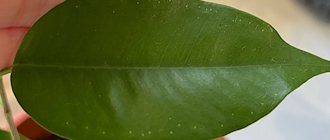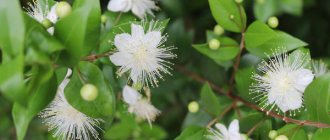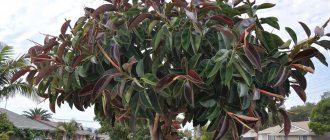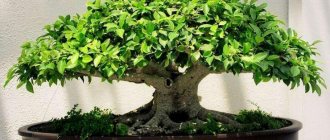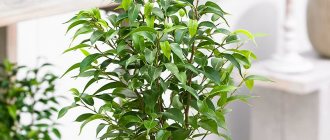Botanical description and characteristics of the plant
Ficus rubber or ficus elastica (lat. Ficus elastica) is a perennial plant of the Mulberry family.
The thick sap of the plant contains large quantities of rubber, which is a raw material for the production of rubber. Thanks to this, the species received its name. The plant was once cultivated on an industrial scale. The juice helps the ficus “self-medicate”: cuts and wounds quickly heal. In its natural environment, rubber ficus is common in the tropical forests of northeastern India and southern Indonesia. The appearance of a ficus growing in its homeland is significantly different from indoors. Thus, wild ficus is capable of reaching a height of 30-60 meters. As a single-trunk tree grows, it develops branches. Aerial roots form on their surface, which take root when they reach the soil surface. This life form of the plant is called banyan.
Living building material
Local residents nicknamed the ficus rubber snake tree due to its numerous hanging roots and even learned to make bridges across the river from the roots of the plant. The plant lives for about 50 years and then dies.
Bridge made of aerial roots of ficus rubbery photo
When grown indoors, the plant can reach a height of 10 m (the average annual growth is 40-45 cm), but by pruning the ficus is limited in growth. Side shoots practically do not appear. If the rubber ficus reaches the ceiling, the top can be cut off without fear. To prevent a large plant from breaking, it will need support.
Living bridge from ficus photo
Decorative in home cultivation are beautiful leathery leaves with a glossy sheen. They are large (up to 30 cm long, about 15 cm wide), in the shape of an oblong oval with a pointed tip. The leaf plates are attached alternately using thick petioles. The surface of the leaf is smooth and shiny, the color is dark green, the central vein is slightly depressed. The reverse side of the sheet is matte, lighter in color. The color of the leaves of many bred varieties is variegated.
Flowering ficus rubber plant
How ficus elastica blooms photo
At home, rubber ficus blooms extremely rarely, however, the flowers are not particularly decorative. Inflorescence-syconium: has the appearance of a capitate or pear-shaped axis with a hole at the top (it is intended for the penetration of pollinators). Syconium is hollow, with small flowers located on the inner wall. If pollination occurs, fig-like fruits will form. They cannot be eaten.
Precautionary measures
In addition to useful rubber, the plant juice contains toxic substances. Its contact with skin or mucous membranes may cause irritation or a severe allergic reaction. If this happens, thoroughly rinse the affected areas with water and seek medical attention if necessary. Therefore, when working with the plant, it is necessary to wear protective gloves. Also limit access to the plant to children and pets.
It is not recommended to grow rubber ficus at home for people suffering from asthma. Substances released by the plant into the air can cause suffocation.
How fast does Ficus rubber grow?
Ficus elastica can be safely classified as a fast-growing house plant: its growth ranges from 40 to 60 cm per year. In natural conditions, the growth rate is much higher: from 120 to 250 cm. Those who want to get a beautiful ficus tree for interior decoration will really enjoy caring for for such a powerful, responsive plant.
Description
The plant Ficus elastica belongs to the genus Ficus and the mulberry family. Thus, its relatives include mulberries, figs and breadfruit. The plant is native to Northeast India, Nepal, Sumatra and Java. This is an evergreen plant, in the wild reaching a height of 30-40 m. At home, however, it is unlikely to grow above five.
The main feature of the tree is its thick sap, from which rubber was previously extracted. True, over time, Hevea began to be used more often for these purposes. But the ficus has become very popular as a houseplant. It has been cultivated for a little over two hundred years. In Soviet times, similar trees stood in schools, offices and homes. Today it is becoming popular again.
So, ficus elastica is a tree whose height can reach 30-40 meters. It is also prone to growing in width. Its roots are aerial, twisting, they descend from the trunks with branches to the ground, where they grow into the ground. This gives the plant a specific shape - a banyan, and is also necessary in order to supply it with additional minerals and vitamins. Because of this feature of the roots, in some countries the ficus is called the snake tree. Because of this, in eastern India this tree is used to create living suspension bridges.
The leaf blades are large, leathery, thick and alternately arranged. The color is dense green, they have an elliptical shape, with a point at the top. Young plates have stipules that are brown with a red tint. After the leaf blades open, they dry and fly off.
The flowers are small and inconspicuous; they can appear only if the ficus is pollinated by wasps from the agaonid family. Only old and large plants can bloom at home.
The fruits (syconia) are spherical in shape, have a diameter of up to 10 mm and resemble small figs, and are inedible.
Ficus grows quite quickly - up to 0.45 m per year. In room conditions, this plant does not have side shoots.
IF YOU ARE INTERESTED IN LEARNING ABOUT OTHER TYPES OF FICUS, WE SUGGEST YOU READ THE FICUS BENJAMIN IN THIS ARTICLE: FICUS BENJAMIN - CARE AT HOME.
Conditions for growing ficus elastica
Does unpretentious mean boring?
Thanks to its ease of maintenance and unpretentiousness in care, rubber ficus has become the most popular decorative foliage plant since the youth of our grandmothers. It could be found everywhere: in homes, libraries, cinemas, educational and other institutions. Then the plant began to be regarded as bad taste, and the time came for oblivion. In the last 10 years, the popularity of ficus rubber has been gaining momentum again, mainly thanks to the work of Dutch breeders. They pleased us with new varieties that can conquer even the most experienced gardeners.
We are constantly busy and in a hurry to get somewhere, and indoor plants add comfort and elegance to the room. Caring for a plant will not take much time and effort; on the contrary, “communicating with a green friend” will help you relax after a busy day at work.
Lighting: where to put ficus elastica?
In order for the ficus to grow and develop well, you must first choose a suitable place for it. Bright, diffused lighting is required throughout the year. Variegated forms especially need this, but avoid direct sunlight. If it is not possible to place it near an east- or west-facing window, slight shading is acceptable (we place the container with the plant in the back of the room or on the northern window sill). Please note that in shading the growth rate will slow down, over time the leaves will begin to fall from the lower part, and it will become bare.
Also, when choosing a location, avoid drafts and exposure to cold air. In winter, do not place near heating devices or radiators.
Air temperature
The temperature regime will need to be moderately warm. During the period of active growth (spring-mid-autumn), the air temperature should fluctuate between 20-25 °C. Wintering must be cool: from late autumn to spring, maintain the air temperature at 15 °C.
How to care for ficus rubber at home
Ficus rubber plant care at home photo
Watering and spraying
It is necessary to water the rubber ficus as the top layer of soil dries to a depth of 3-4 centimeters. During the warm season, watering is carried out 2-3 times a week, in autumn and winter - approximately once every 7-10 days. The proper level of air humidity in the room is achieved by regularly spraying the plant. With the onset of the cold season, replace spraying by wiping the leaf plates with a damp sponge. The plant should be watered and sprayed with warm and purified water (melt, rain, filtered or settled for at least a day).
Clean and shiny leaves
To maintain a glossy shine, gardeners recommend polishing the leaves with a soft cloth moistened with a decoction of onion peels or non-alcoholic beer.
Feeding
To maintain stable growth and a spectacular appearance of the plant, the ficus will need to be fed throughout the spring and summer. Use complex mineral fertilizers with a high proportion of nitrogen. Prepare the fertilizer in liquid form and apply it every 15 days.
Causes
Transplanting a plant is a responsible and labor-intensive procedure that requires compliance with a number of important requirements. First of all, you should make sure that the ficus really needs to change the pot and substrate. The following signs indicate that it is time to replant the ficus:
- root growth through holes for water drainage;
- quick drying of a clod of earth after watering;
- young leaves are much smaller in size than old ones;
- waterlogging of the soil in the pot.
Root germination
The fact that the ficus roots have become cramped in the pot is evidenced by their active germination outside the container. In search of free space, the roots begin to penetrate through the drainage holes, where they can be seen with the naked eye. Often the roots intertwined with each other crawl out to the surface of the ground, trying to escape beyond the edges of the pot.
Quick drying of the soil
One of the sure signs that a plant needs urgent replanting is the rapid drying of the earthen clod after watering. When the volume of the root mass exceeds the volume of the earthen ball, moisture is not retained in the substrate, but is actively absorbed by the roots. This leads to a significant increase in the frequency of watering.
Leaf Size Difference
If young ficus leaves cannot match the size of old foliage, this clearly indicates that the plant lacks the appropriate resources - moisture and nutrients. A shortage of these resources occurs when the pot becomes too small for the ficus, and the intertwined roots begin to cope poorly with their functions.
This, in turn, requires an emergency transplant.
Swamping of the substrate
The consequence of increasing the frequency of watering is souring and waterlogging of the soil substrate in the pot with the plant. As a result, the earthen lump begins to emit an unpleasant odor, and a specific coating forms on the surface of the soil. This greatly increases the risk of developing root rot, which can destroy the plant.
Other
Ficus trees recently purchased at the store are subject to transplantation. After purchasing, they are kept in quarantine for 2-3 weeks, isolated from other plants, and then prepared for replanting. The need for this procedure here is due to the fact that store-bought substrate is usually not suitable for further growing ficus plants. This soil mixture is used to facilitate the transportation of plants. It is denser, poorly drained, and poor in nutrients. It is highly undesirable to use store-bought soil mixture for growing indoor plants.
When calculating the timing of plant transplantation, it is necessary to take into account their age.
For example, it is advisable to replant young ficus trees less than three years old every year. At this age, plants are actively developing, increasing their green and root mass, and therefore they require regular replacement of old cramped pots with more spacious containers.
Older trees, whose age ranges from 3 to 6 years, are transplanted once every two years. Plants at this life interval slightly slow down the pace of their development, although they continue to form new shoots and roots. By replanting a plant of this age according to the schedule, the gardener provides his green pet with optimal and comfortable living conditions.
Mature ficuses aged 6 years or more are replanted every 5 years. Periodically, to renew the depleted soil, carefully remove the top layer from the pot and fill it with fresh nutritious soil.
How to form ficus rubbery
Formation of rubber ficus at home photo
To form a beautiful compact crown and ensure dense leaf growth, ficus should be pruned. Carry out the procedure in early spring, armed with a sharp sterile knife or scalpel. Do not forget to wash the tool with warm water after use.
How to make a ficus branch?
As a rule, pruning the top does not lead to the growth of side shoots, but only activates the upper growth point. The desired result is achieved by pruning the top 5-6 internodes; the height of the plant should not be less than 70 cm.
To form a branching bush, you can use the following techniques:
- Tilt the top of the young ficus down as far as possible and secure it with a cord. The bud that is highest will become active and will sprout. Then the top can be “released”.
- Try piercing the central shoot with a needle, do this to a depth of 1/3 of the diameter. You can make several punctures, moving from the top down. This procedure will slow down the growth of the top.
- It is also useful to remove weak, thin shoots so that the remaining ones are more powerful.
After removing excess branches or pruning, juice appears in the wounds. Wipe it off carefully to prevent rotting and infection of the wound.
A month after pruning, be sure to fertilize the ficus with complex fertilizer (for example, Kemira Lux) according to the instructions in order to provide additional nutrition to the weakened plant.
For “lazy” gardeners, a simple way to get a compact, dense bush is perfect: just plant 3-5 plants in one pot, and when they reach the desired height, pierce the tops of the shoots so that they stop growing. This will be enough to get the perfect crown of a handsome ficus without any hassle.
The ficus has taken root. Preparatory procedures - preparing cuttings and forming roots in water
Regardless of the choice of plant - benjamina ficus, rubber-bearing or dwarf ficus - the process of preparing for propagation is the same. Harvesting cuttings begins in the spring and continues until early June during the period of active plant growth. A cutting 10 to 15 cm long is cut at an angle with a sharp knife or pruning shears. The choice of the place from which the planting material will be obtained is not so important. This can be either the top of the plant or the stem shoot. The main thing is that the ficus is not young, otherwise it will not reproduce and take root. Choose a flower with woody shoots.
At the cut, you will see milky juice begin to ooze from the cuttings. This adhesive composition clogs the conducting paths, covering the cut site with a dense plug, which prevents the young plant from developing. Therefore, we wash the cuttings until the sticky residues completely disappear or leave them to soak for a couple of hours in warm water. Next, dry the prepared sections in the open air for 2 hours. Let's start rooting. The easiest option is to place the prepared branches in water. To make them grow roots faster, make 2-3 vertical cuts along the base line, leaving only the top leaves and removing the bottom ones.
Biostimulants, for example, 2-3 drops of Epin, help speed up the rooting process. Activated carbon also copes well with the task. Just crush 1 tablet and add it to a container of water.
Ficus benjamina and other representatives of this plant take root well at a temperature of 25 ° C and air humidity of 80%. Creating a mini-greenhouse helps achieve such indicators. To do this, we put a plastic bag, a plastic cup or a bottle scrap on top of the container. As the water evaporates, add liquid. On average, it takes 3-4 weeks for a ficus to root. Initially, white growths appear at the base, from which roots later form. When they reach 2–3 cm, we transplant the ficus into nutrient soil. You should not keep the plant in water - its roots will begin to rot, and it will not be possible to grow a healthy and beautiful flower.
How to trim rubber ficus and form a crown, watch the video:
Ficus tolerates pruning well at any time of the year, but is most responsive to it in late spring and early summer. Experts consider this time to be the most favorable for all types of pruning. Sanitary pruning can be done as needed: remove weak and damaged branches at your convenience.
When working, be sure to wear rubber gloves to protect yourself from the poisonous juice.
Replanting ficus rubber
Replant young ficuses (up to 3 years old) annually, then every 2-3 years. Focus on filling the container with roots. Ficus is a long-liver, and replanting large plants is difficult, so the procedure is often replaced by updating the top layer of the substrate. Remove it to a depth of 4 cm, act carefully so as not to damage the roots. Don’t delay replanting and replacing the top layer of soil - do it in early spring before growth begins.
With each transplant, increase the depth of the container by 5 cm and the diameter by 3-5 cm. If you initially take a large pot, the plant will begin to rapidly grow its root system to the detriment of the development of the above-ground part.
There is nothing complicated about replanting a plant:
- Place a four-centimeter drainage layer at the bottom of the prepared container. You can use expanded clay, pebbles, vermiculite, brick chips or a mixture of them.
- Transfer the ficus together with the earthen clod, and fill the voids with substrate.
Priming
The plant requires light and loose soil. You can purchase a special substrate for ficus plants at a flower shop. If desired, prepare the soil mixture yourself. You will need turf and leaf soil, peat, coarse sand, mix all ingredients in equal proportions.
After replanting, the leaves at the bottom may fall off, but there is no reason to worry. The adaptation period after transplantation lasts about 15 days.
The soil
Selecting the right soil is an important point for growing indoor plants.
The substrate must be neutral or slightly acidic, breathable, and retain moisture well.
A mixture with a high clay content is definitely not suitable. There will be stagnation of moisture in it, which will cause rotting of the roots.
Different compositions are selected depending on the age of the plants.
Young specimens need maximum looseness, while for adults the soil should be quite dense.
The composition for young specimens is leaf humus, peat, sand in equal quantities.
For adults – humus, turf soil, peat, sand (1:1:1:1) or humus, turf, sand (2:2:1).
The necessary looseness is also achieved by adding a small amount of expanded clay.
These porous pebbles provide breathability, absorb moisture and fertilizers, and then gradually share them with the roots.
The addition of vermicompost stimulates the growth of ficus and improves survival in new soil.
You also need to add lime or dolomite flour to the soil. These minerals deoxidize it and enrich it with magnesium and calcium.
You can add wood ash, it also contains trace elements.
The composition is always indicated on the packaging, and you can make the right choice to ensure maximum comfort for your pet.
Reproduction of rubber ficus at home
At home, rubber ficus is propagated vegetatively. There are several ways, let's look at each of them in detail.
Propagation of rubber ficus by cuttings
Carry out the procedure in the spring.
- Cut cuttings 10-15 cm long.
- Hold them under running warm water until the milky juice stops flowing.
- Remove the leaves from the bottom, and roll the rest into a tube and secure with an elastic band. This is done to reduce the area of evaporation.
- The process of rooting cuttings of variegated varieties does not always end successfully, so before planting it is better to keep them in a solution of a growth stimulator (Heteroauxin, Kornevin, Epin).
- For rooting, plant the cuttings in a sand-peat mixture.
How to root cuttings of ficus elastica Result of rooting in water photo
It is more reliable to root variegated forms in greenhouses with bottom heating. With some creativity, you can create a greenhouse on a windowsill. Cover each cutting with a cut plastic bottle or glass jar; if the structure turns out to be unreliable, one of the household members may accidentally knock it over.
It is better to wrap each cutting in a plastic bag. Any shelter will need to be raised daily for ventilation. Provide diffused lighting, maintain the air temperature at 25 °C, and water as needed. When new leaves appear, you can plant the cuttings in individual containers with a suitable substrate.
Ficus elastica cuttings rooted in the substrate
Don't try to root leaf cuttings: they will produce roots but never produce shoots. There is even a special term given to this phenomenon: “blind leaves.”
Rooted leaf of ficus rubber plant photo
Rooted leaves will remain healthy for a long time, and then die for no apparent reason. This is an amazing phenomenon that only some plant species are capable of.
Reproduction by layering
Variegated forms of rubber ficus successfully reproduce by layering:
- Make a cut on the stem with a depth of 1/3 of its thickness, insert a match into it so that the edges do not close.
- Wrap the cut area with damp sphagnum moss, additionally wrap it with polyethylene on top and secure the structure with tape or cord.
- As soon as you notice the roots formed through the transparent film, cut off the shoot below the layer along with the roots and plant it in the substrate.
Pests of ficus rubber
The plant has strong immunity to disease, but is occasionally damaged by insects. Among them are spider mites, scale insects, thrips, and mealybugs.
Let's take a closer look at the signs of damage and methods of pest control:
- Spider mites are small red-brown insects. It settles on the reverse side of the leaf and leaves secretions in the form of small whitish cobwebs. Small dark spots (traces of tick bites) can be found on the surface of the leaves; soon the leaf plates will begin to turn yellow and fall off. The pest actively reproduces at high temperatures and dry indoor air, so change the conditions under which the plant is kept. Wash the plant under running warm water, carefully treating the back of the leaves. To get rid of the pest, you can use folk remedies: spraying the leaves with tobacco infusion and soap solution (for 1 liter of water we take 50 grams of soap and 100 grams of tobacco dust) or Dalmatian chamomile infusion. After a couple of hours, wash the plant with warm water. If necessary, re-spray after 10 days. Treatment with the insecticidal drug Actellik gives good results.
- Obvious signs of scale insect damage: the appearance of dots, dark spots and a sticky coating on the leaves; the pests themselves form growths in the form of dark tubercles. Moisten a cotton swab with insecticide and remove pests mechanically (carefully wipe the leaves and stem). Then spray the leaves with the same insecticide or a product you prepare yourself (a tobacco-soap solution with the addition of a small amount of denatured alcohol or kerosene).
- Thrips are most often brought into the house with a new plant purchased at a flower shop or from hand. The pest is invisible to the naked eye, so it is better to quarantine the flower after purchase (separate from others). Thrips feed on the sap of the plant, and give themselves away as puncture marks - small dark dots on the leaves. It is necessary to treat with an insecticidal preparation (Confidor, Ankara, Fitoverm, Vertimek).
- The mealybug is a small insect covered with cotton-like pubescence, and it also leaves a discharge similar to lumps of cotton wool. The pest settles in entire colonies on leaves and stems. Soak a cotton pad in ethanol or formic alcohol and thoroughly wipe all parts of the plant. Then treat with onion or garlic infusion with the addition of a soap solution. After a few hours, wash the ficus under a warm shower.
Pests and diseases
This tree is quite resistant to insects and diseases, so it grows without problems in any conditions. Occasionally, spider mites with scale insects appear on ficus. If such a problem occurs, a solution of tobacco dust will help. To prepare it, add 4 tablespoons of tobacco dust to a liter of water and add a little soap. We process it, wait a couple of hours and wash it off the ficus. Scale insects can be removed using a cotton swab.
Among the diseases, the most popular are powdery mildew, anthracnose, gray mold and sooty fungus, as well as cercospora.
If powdery mildew appears, the leaves of the plant should be washed with laundry soap and treated with a fungicide. We act in the same way when anthracnose appears. Gray rot appears when the soil and air are waterlogged. During treatment, watering is kept to a minimum. We treat ficus with antifungal drugs. Sooty fungus and cercospora fungus are also treated with fungicides. Root rot in ficus cannot be treated. The ficus and its pot can only be destroyed.
Possible problems
Ficus rubber does not have any particular problems. However, sometimes bad things happen.
Leaf blades are falling
The lower ones fall off constantly - this is normal. The plant is just getting old. If the ficus also loses other leaves, the culprit may be overdried soil in the pot, poor lighting, drafts, a drop or rise in temperature, excessive moisture and “overfed” soil.
Leaf blades turn yellow
This happens when the soil, and the ficus itself, are overfed with all kinds of minerals. What to do? First, rinse the substrate. Pour a volume of water equal to three such tubs into a tub with a flower. After this, the plant cannot be fed for eight weeks. Sometimes leaf blades turn yellow due to the fact that there is a lot of salts in the soil. Here you can only replace the soil. Sometimes a pot that is too large is to blame for yellowing leaves. Everything is simple here: we transplant the tree into a smaller container.
Occasionally, leaf blades turn yellow due to the fact that rot has appeared on the roots of the ficus. You can identify it by smell. We take the bush out of the tub, wash the roots, free them from the soil, and inspect for the presence of areas with rot. We cut them out, only carefully and with a perfectly sharp blade. Sometimes, however, it is impossible to save a ficus with rot.
Why do the leaves of rubber ficus turn yellow?
Ficus rubber leaves turn yellow
This happens for a number of reasons:
- Salinization of the substrate, which happens when watering with low-quality water. It is better to replant the plant in new soil and follow the watering recommendations in the future;
- Oversaturation of soil with fertilizers. Do not overfeed the ficus initially, because it will have to be replanted. If the transplant was carried out recently, it is better to save the plant by washing the substrate through top watering. Spill the soil with an amount of water equal to three volumes of the pot;
- The container in which the flower grows is too large. Transplant the ficus into a smaller pot;
- Root rot. The leaves turn yellow and the substrate smells rotten. It is urgent to transplant the plant into fresh soil. Cut off the rotten areas, be sure to treat the cut areas with a fungicide, and disinfect the container.
If the leaves of the ficus rubber plant turn yellow, you now know what to do. The main thing is not to make mistakes in care, and no difficulties will arise.
Harm, benefit
Ficus has large leaves that enrich and purify oxygen in the room. It has also been noted that ficus helps cope with anxiety.
However, rubber ficus can cause allergies and dermatitis. The problem is rubber, which may well be an allergen. It is better not to keep it at home if you have a small child, or if you have asthma (or someone in your household is sick).
Useful properties of the plant
Ficus rubber with large, glossy, green or variegated leaves not only fits well into the interior of any room, but also has a number of useful properties. And in Buddhism it is revered as a sacred plant.
The flower purifies the air in the room: benzene, phenol, trichlorethylene and other toxins are processed into sugars and amino acids.
Based on the crushed leaves and juice of the plant, preparations are made for the prevention of cancer, the treatment of fibroids and uterine fibroids, and mastopathy. For arthritis, radiculitis, osteochondrosis and hemorrhoids, apply compresses and lotions from ficus juice.
Ficus rubber: signs and superstitions
There are many beliefs in the world regarding ficus. According to some, it attracts happiness, prosperity and well-being to the home, while according to others, it breaks up couples and dooms women to loneliness.
Buddhists and followers of Ayurveda are confident in the extremely beneficial effects of the plant. Ficus is able to absorb the energy of anxiety, anger, and panic. A soft and peaceful atmosphere will reign in the room, setting you up for tranquility. This is good for both home (apartment) and office, meeting room, or any institution. To enhance the effect, the leaves of the plant should be directed to the west.
From an energy point of view, ficus should not be placed in the central, southern and northern parts of the house. This arrangement does not allow him to show his abilities; on the contrary, negative energy will begin to accumulate in the room.
According to Feng Shui, the plant also has a positive effect. And where you put it, that’s how it will “work”.
- In a spacious room - fortunately, positive emotions and impressions.
- When placed in the corridor or at the entrance to the house, it will protect the household from the evil and negativity of the surrounding world (from ill-wishers, for example).
- In the kitchen - to abundance, in this house no one will go hungry.
- The plant attracts money. Place it in your office or work area, then expect profitable deals, career growth and salary increases.
- Couples dreaming of children are recommended to place the plant in the bedroom. Plant a young ficus in a new pot and place it at the woman’s head. Take care of the plant as if you were caring for your child, then the appearance of the baby in reality will not be long in coming. In the future, the energy of the plant has a beneficial effect on the course of pregnancy and childbirth.
In our culture, ficus has long been considered a muzhegon, “surviving” men from the house. Under no circumstances should it be given to newlyweds or grown by unmarried people. In the first case, the couple will separate, and in the second, the girl will not meet her soulmate.
Ficus can rightfully be called one of the best decorative foliage plants and one should not pay attention to superstitions and signs.
Which dishes should I choose?
Material
It can be anyone, you just need to take into account the characteristics of each.
Clay containers absorb moisture well, which means they will protect the plant from accidental waterlogging. But this feature must be taken into account before planting.
To prevent a clay or ceramic pot from taking all the moisture from the soil, keep it in water for an hour.
Plastic does not absorb water. When choosing it, you should increase the height of the drainage layer at the bottom.
It is also recommended to lay a layer of peat or sphagnum on it - this will improve the aeration of the roots.
Wooden tubs are suitable for old ficus trees. Before use, they are burned from the inside to form a thin layer of charcoal.
It plays a disinfecting role, deoxidizes the soil and protects wood from rotting.
The tubs must be made of oak or pine. Other types of wood quickly become unusable, and you will have to replace it at the wrong time, and this is not advisable for mature specimens.
Form
Standard pots with approximately equal height and diameter will do.
A dish that is too tall or wide will not work - the soil, which has not been absorbed by the roots, will become acidic. For some species, large spaces are generally contraindicated.
An exception is when growing ficus in bonsai style. For such specimens, select flat and wide dishes, with a height of no more than ten centimeters.
Varieties of rubber ficus with photos and names
Varieties with monochromatic leaves:
Ficus elastica Abidzhan Ficus elastica Abidzhan photo
Abidzhan - the length of the oval leaf blades is 25 cm, width - 18 cm. When young, the leaves have a dark burgundy, almost beetroot tint, then become deep dark green. The central vein below retains a burgundy hue.
Ficus elastica Melanie Ficus elastica Melany photo
Melanie is a miniature plant. The leaf length is about 15 cm, width - 8 cm. The leaf blades are shiny, dark green in color. The central vein is slightly depressed; on the reverse side they are reddish in color. It is noteworthy that a young bush is capable of branching even without pruning.
Ficus elastica Robusta Ficus elastica 'Robusta' photo
Robusta - the plant has a powerful rhizome, a thick trunk, large and fleshy leaves, which fully justifies the name of the variety (from the English robust - massive, strong, strong). The leaf blades are broadly oval in shape with a pointed tip, which is slightly bent downwards in the same way as the edges. The leaf color is dark green.
Ficus elastica Burgundy Ficus elastica Burgundy photo
Burgundy is an elongated leaf, about 30 cm long and 10 cm wide. The shade is dark burgundy, the petiole is pinkish.
Ficus elastica Black Prince Ficus elastica Black Prince photo
Black Prince - a leaf blade of the same length as the previous variety, the width is about 18 cm. The leaf blade is eggplant-colored, the central part is lighter.
Ficus elastica Decora Ficus elastica Decora photo
Decora – the leaf plate is long (about 30 cm) and wide (about 20 cm). The leaves are almost heart-shaped in shape, forming a groove (both sides of the central vein are bent, like a half-opened book). The color of the leaves is rich green, the vein from the petiole is reddish, and above it is creamy.
